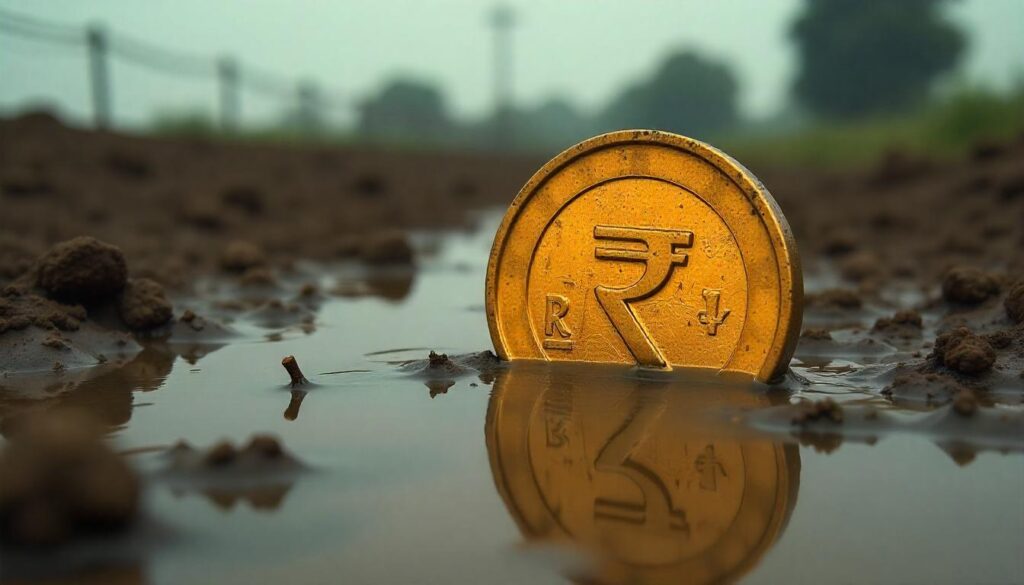
The Indian rupee faced a rough ride this week, shaken by rising tensions between India and Pakistan. A sharp comment from Pakistan’s defence minister rattled nerves across financial markets, sending the rupee briefly tumbling to 85.50 against the US dollar before clawing back some lost ground.
While the situation appears to have cooled slightly, the sudden jolt has left investors wondering: is this just a passing storm — or the start of something deeper?
🌪️ What Triggered the Turbulence?
It all started with renewed unrest along the sensitive borders. Reports of a militant attack in Kashmir, followed by strong accusations and aggressive language from Pakistan, set alarm bells ringing across trading floors.
Markets hate uncertainty, and the idea of escalating cross-border risks was enough to push traders into safe assets like the US dollar, while dumping emerging market currencies — including the rupee.
📈 How the Rupee Managed a Quick Comeback
Interestingly, the rupee’s sharp fall didn’t last long. A few factors worked in its favor:
- The US dollar weakened globally, thanks to growing doubts over the Federal Reserve’s next moves.
- India’s massive foreign exchange reserves — among the world’s largest — reassured traders that the Reserve Bank of India (RBI) has enough firepower to prevent any panic.
This combination helped the rupee recover part of its losses, though not enough to fully erase the fears still lurking underneath.
🔎 Why This Matters Beyond Just the Exchange Rate
A sliding rupee has real-world consequences, far beyond currency desks and trading apps.
🛢️ 1. Higher Prices for Essential Goods
India imports large quantities of crude oil, electronics, and industrial goods. A weaker rupee makes all these imports more expensive, and the extra cost often trickles down to consumers. In short: a persistently weak rupee could mean higher petrol prices and costlier gadgets.
🧵 2. A Golden Window for Exporters
On the flip side, Indian exporters — from software companies to textile firms — might find themselves smiling. A weaker rupee makes their products cheaper and more attractive in global markets, giving a boost to export revenues.
💰 3. Jitters in the Stock and Bond Markets
Foreign investors often react swiftly to rising political risks. If tensions continue, we might see money flowing out of Indian stocks and bonds, adding extra pressure on both markets and the currency.
⚡ Brace for a Bumpier Ride Ahead
Market volatility is already ticking higher. Currency traders are pricing in bigger daily swings, and hedging costs have climbed sharply over the past few sessions.
Clearly, the market expects that the geopolitical situation might stay tense for a while, even if there’s no immediate escalation.
🎯 Expert Voices: How Serious Is This?
Not everyone is hitting the panic button yet. Most analysts agree that while short-term turbulence is likely, India’s economy remains strong enough to weather the storm.
“Unless we see military action or full diplomatic breakdowns, this currency shock should be manageable,” says Nitin Prasad, Chief Market Strategist at PineRock Financial.
He notes that India’s economy, expected to grow over 6.5% this year, provides a sturdy foundation to ride out temporary political squalls.
🧠 Smart Moves for Investors
Here’s what experts suggest for investors in such uncertain times:
- Stay diversified: Relying too heavily on stocks or bonds from one region can be risky during geopolitical shocks.
- Watch oil prices: Rising crude costs could fuel more rupee weakness and stoke inflation.
- Follow RBI signals: The central bank’s actions can provide early hints about currency stabilization efforts.
Most importantly: don’t make emotional decisions based on daily headlines.
🛡️ Final Thoughts: Stay Alert, Not Anxious
The rupee’s wobble following fresh border tensions reminds us that markets are sensitive — not just to profits and numbers, but to real-world events that shift public sentiment and investor psychology.
For now, caution will rule the trading floors. But India’s fundamentals — robust growth, healthy forex reserves, and resilient consumer demand — act as a strong shield against long-term damage.
Smart investors will keep a close watch — without losing their cool.
📌 Quick Recap:
- The rupee slipped to 85.50/USD after Pakistan tensions spiked.
- A weaker US dollar and India’s forex cushion limited the damage.
- Importers could feel the pinch; exporters may benefit.
- Volatility remains high, but India’s economy looks strong underneat
stay here for more updates :- marketdarpan.com


